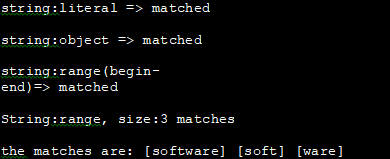C++ 正则表达式教程:C++ 中的正则表达式与示例
C++ 正则表达式教程解释了 C++ 中正则表达式的工作,包括正则表达式匹配、搜索、替换、输入验证和标记化的功能。
几乎所有的编程语言都支持正则表达式。 C++ 从 C++11 开始直接支持正则表达式。除了编程语言之外,大多数文本处理程序(如词法分析器、高级文本编辑器等)都使用正则表达式。
在本教程中,我们将探讨正则表达式的一般细节以及 C++ 编程方面的细节。
正则匹配中的基础符号
^开头
()组
[]或,
{}几次
$结尾
1. C++ 中的正则表达式 (Regex)
正则表达式是包含一系列字符的表达式,这些字符定义了可用于字符串搜索算法、查找或查找/替换算法等的特定搜索模式。正则表达式也用于输入验证。
大多数编程语言要么为正则表达式提供内置功能,要么通过库提供。从 C++11 开始,C++ 通过 标准库提供正则表达式支持。
用于解析正则表达式的正则表达式处理器将其转换为内部表示,该表示被执行并与表示正在搜索的文本的字符串匹配。 C++11 使用 ECMAScript 语法作为正则表达式的默认语法。 ECMAScript 很简单,但它提供了强大的正则表达式功能。 让我们看看我们在正则表达式中指定的一些模式,如范围规范、重复模式等。
1.1 范围规范
指定字符或文字的范围是正则表达式中使用的最简单的标准之一。
例如,我们可以指定一个从a到z的小写字母范围,如下所示:[a-z],这将只匹配一个小写字符。
下列条件:[A-Za-z0-9]
上面的表达式指定了包含一个大写字母、一个小写字母和0到9之间的数字的范围。
上述表达式中的方括号([])具有特殊含义,即用于指定范围。如果你想包含一个括号作为表达式的一部分,那么你需要转义它。
那么下面的表达式,[\[0-9]
上面的表达式表示一个左括号和一个0到9范围内的数字作为正则表达式。
但请注意,当我们使用 C++ 编程时,我们需要使用 C++ 特定的转义序列,如下所示:[\\[0-9]
1.2 重复模式
我们上面指定的范围示例只匹配一个字符或文字。如果我们想匹配多个字符,我们通常在模式中指定“表达式修饰符”,从而使其成为一个重复的模式。
表达式修饰符可以是+,表示匹配一个模式出现一次或多次,也可以是*,表示匹配一个模式出现零次或多次。
例如,下面的表达式,
[a-z]+ 匹配 a、aaa、abcd、softwaretestinghelp 等字符串。请注意,它永远不会匹配空白字符串。
[a-z]*将匹配一个空白字符串或任何上面的字符串。
如果要指定一组字符匹配一次或多次,则可以使用括号,如下所示:(Xyz)+
上面的表达式将匹配Xyz、XyzXyz和XyzXyz等等。
2. C++正则表达式的例子
考虑一个匹配 MS-DOS 文件名的正则表达式,如下所示。
char regex_filename[] = “[a-zA-Z_] [a-zA-Z_0-9]*\\.[a-zA-Z0-9]+”;
上面的正则表达式可以解释如下:
匹配一个字母(小写,然后大写)或下划线。然后匹配零个或多个字符,其中每个字符可以是字母、下划线或数字。然后匹配文字点(.)。在点之后,匹配一个或多个字符,其中每个字符可以是表示文件扩展名的字母或数字。
3. C++正则表达式中使用的函数模板
现在让我们讨论在 C++ 中编写正则表达式时的一些重要函数模板。
3.1 regex_match()
此函数模板用于匹配给定的模式。如果给定的表达式与字符串匹配,则此函数返回 true。否则,该函数返回 false。
以下是演示 regex_match 函数的 C++ 编程示例。
#include 
在上面的程序中,首先,我们使用regex_match函数将字符串" softwareTesting "与正则表达式" (soft)(.*) "匹配。随后,我们还通过向regex_match传递字符串对象、范围等来演示regex_match的不同变体。
3.2 regex_search()
函数regex_search()用于在字符串中搜索匹配正则表达式的模式。
考虑下面的c++程序,它显示了regex_search()的用法。
#include 
我们先指定一个字符串,然后使用regex对象指定一个正则表达式。这个字符串和regex连同smatch标志类型一起被传递给regex_search函数。该函数在输入字符串中搜索第一个出现的模式,并返回匹配的字符串。
3.3 regex_replace()
函数regex_replace()用于用字符串替换与正则表达式匹配的模式。
让我们使用一个c++程序来演示regex_replace()函数。
#include 
这里,我们有一个输入字符串。我们提供了一个正则表达式来匹配以 p 开头的字符串。然后我们将匹配的单词替换为website。接下来,我们将website替换回portal。
4.C++输入验证
我们已经讨论了使用regex进行模式匹配的主要函数模板。值得注意的是,regex服务的主要目的是输入验证。可以使用regex表达式验证从标准输入设备输入的输入。
检查下面的程序,以演示如何使用regex验证传入的数据。
#include 
这个程序匹配用户输入的输入,以验证它是否是整数。上面的输出显示,当输入一个整数时,它会给出一个适当的消息,而当输入任何其他数据时,它会将该消息作为无效输入。
5.总结
Regex在搜索引擎中用于搜索模式,搜索和替换应用程序的对话框,如字处理器和文本编辑器。Regex也用于UNIX实用程序,如sed、awk以及程序的词法分析。
在本教程中,我们已经看到了用于匹配、搜索和替换模式的函数。使用这些函数,我们基本上可以开发一个高效的应用程序,使用regex实现所需的功能。
Regex允许通过修补模式有效地验证输入或搜索并替换字符串,这可以使用很少的行来完成。
参考目录
https://www.softwaretestinghelp.com/regex-in-cpp/